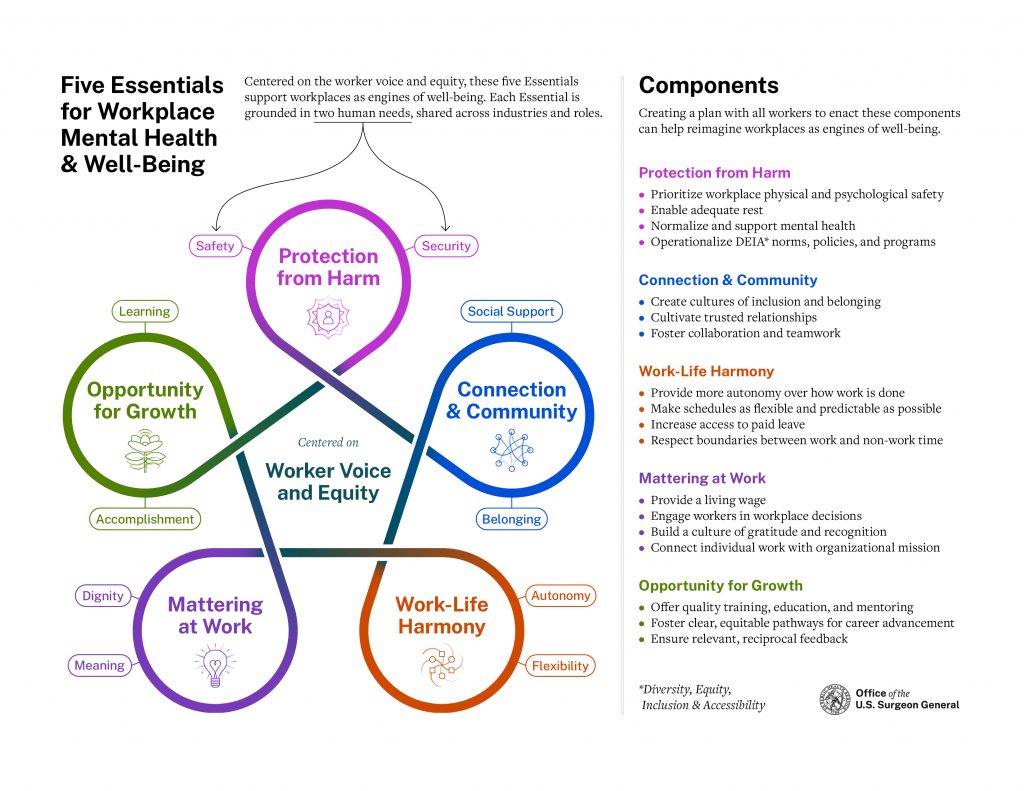In case you missed it, on October 20, 2022, the U.S. Surgeon General, Dr. Vivek Murthy, released a new Framework for Mental Health & Well-Being in the Workplace.
According to the press release, this Framework outlines “the foundational role that workplaces should play in promoting the health and well-being of workers and our communities. As reports of ‘quiet quitting’ and the Great Resignation have shown, the COVID-19 pandemic has changed the nature of work for many and the relationship that some workers have with their jobs.”
Dr. Murthy also provided a short overview video about the Framework. He situates the need for the Framework in the tension between the value people derive from their work, and the negative toll workplaces can take on people. 84% of workers in a 2021 survey reported that their workplaces contributed to at least one mental health challenge.
The Framework offers the goal that “We can build workplaces that are engines of well-being, showing workers that they matter, that their work matters, and that they have the workplace resources and support necessary to flourish.”
Five Essential elements make the heart of the Framework: Protection from Harm; Connection and Community; Work-Life Harmony; Mattering at Work; and Opportunities for Growth. These are captured in a graphic.

Workplace wellness initiatives are not news to anyone in healthcare. Physician burnout was labelled a public health crises before the pandemic. In October of this year, The National Academies released its own National Plan for Health Workforce Well-Being, saying “The capacity and well-being of the U.S. health workforce has been under threat for years by an epidemic of burnout, and two years of the COVID-19 pandemic has further exacerbated this systems issue. Now more nurses, physicians, and state and local public health department employees than ever are considering leaving their professions.”
From the time I entered the health sector, I’ve heard stories from practitioners and students about their individual workplace wellness activities. Though no one disputes the need for the attention to employee wellness, I’ve heard some dissatisfaction with the ways in which individual organizations have gone about it. One of the critiques centers around approaches that favor individual-level rather than systems-level actions. One med student put it this way: “They’re making us go to an ice cream social on the lawn, while the building behind us is on fire.”
So I was hopeful when I read the Surgeon General’s Framework, and noticed its explicit systems-level orientation.
For example, one component of “Protection from Harm” states: “Organizations can further normalize and support mental health by modeling, communicating, and regularly promoting services.” Another states: “Employers can prioritize diversity, equity, inclusion, and accessibility (DEIA) norms by putting relevant policies and programs in place. Inclusive leadership is vital for fostering diversity among teams and is required to support a work environment where all team members feel valued and represented.” Leadership, policies, normalizing, these terms point to systems-level actions, good to see.
Communication is included (or heavily implied) in each of these activities. Again, I’m hopeful, and curious about how communication related to these initiatives might play out on the ground. How would you want this Framework taken up and put into play at your organization? What would make it onto your wishlist for system-level actions in your department?
I look forward to digging in and spending more time on the Framework and its associated resources. There are many–case studies, toolkits, assessments, tips, research, and even reflection questions. I’ll plan a future episode on what I find!
